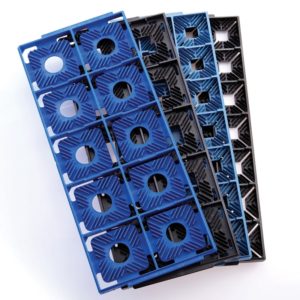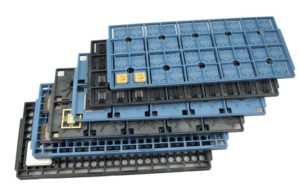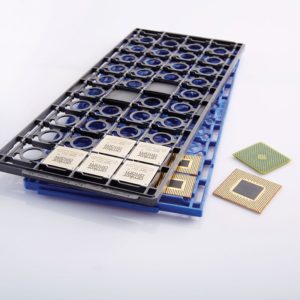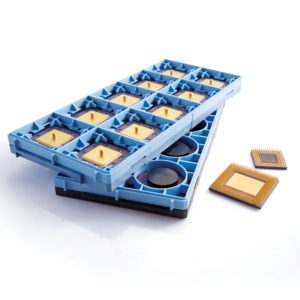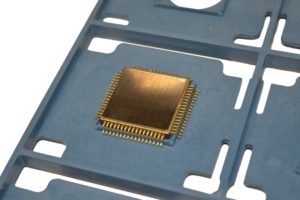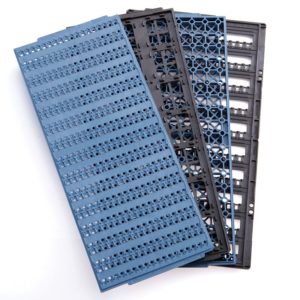JEDEC Trays are a reliable, proven method to handle and process parts in an automated environment. They have spread beyond the original semiconductor industry and are being used for other types of electronic components, optical and photonic products, and purely mechanical parts. Pick and place automation, ESD protection, and utilization of standardized process equipment are the most common reasons companies choose to use JEDEC trays.
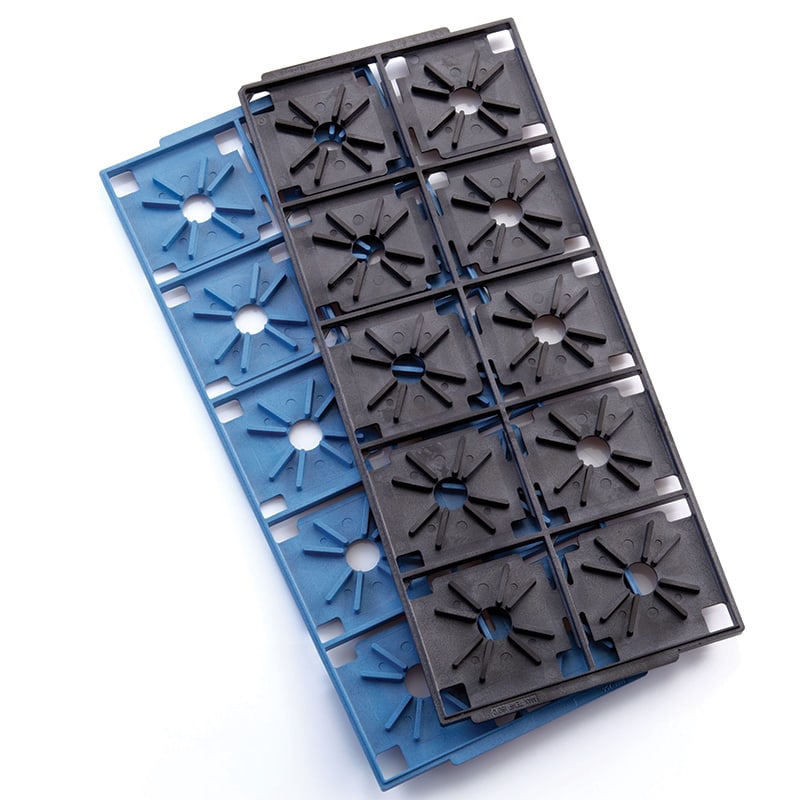
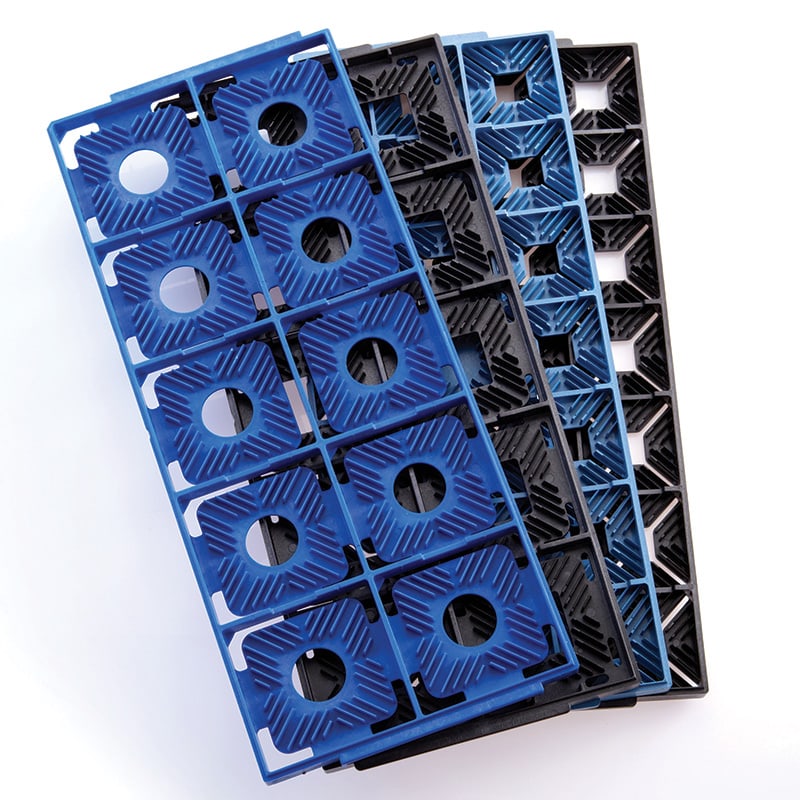
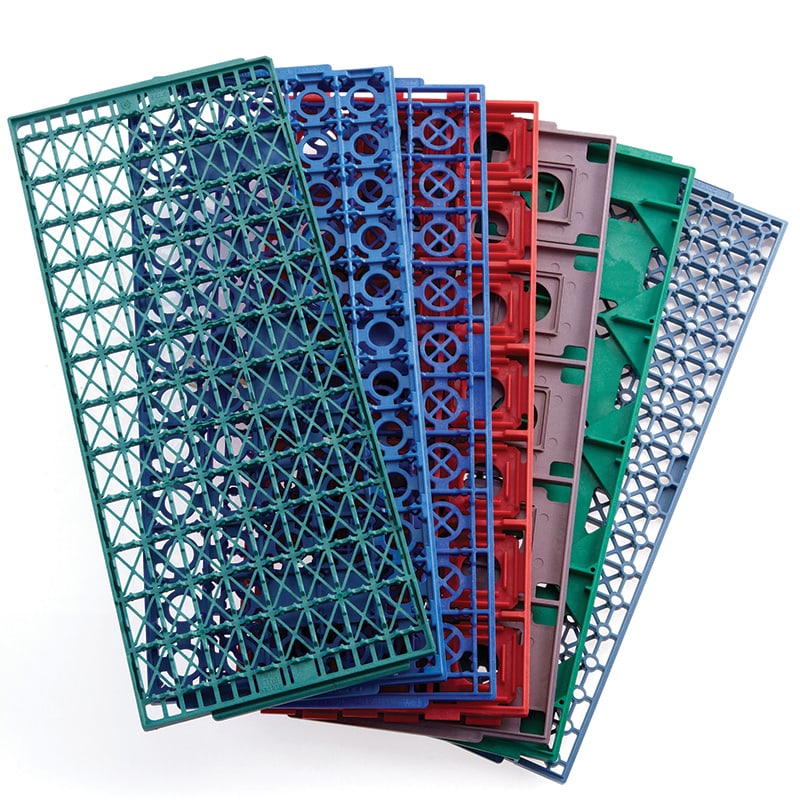
Importance of JEDEC Trays in the Electronics Industry
JEDEC (Joint Electronic Device Engineering Council – www.jedec.org) creates open standards for the microelectronics industry, ensuring product interoperability, benefiting the industry and ultimately consumers by reducing product development time and costs while increasing efficiency and productivity. JEDEC trays all are the same size, with a standardized outline, and required features. Putting parts in a JEDEC tray ensures that your parts can be processed in industry-standard automation equipment like pick and place machines, inspection, laser marking, testing, and dispensing equipment. Commercially available JEDEC tray feeders can be easily added to custom process machines. When you use JEDEC trays, you get an instant benefit from decades of experience and access to an installed base and continuing supply of automation tools.
Benefits of JEDEC Trays
Industry Standard
JEDEC matrix trays are recognized and understood. They give you instant access to equipment and accessories. JEDEC outlines have become the common language of automation.
Precision Built In
JEDEC outlines have well established reference features and datums. The outline dimensions and tolerances take the risk out of equipment design, accelerating development time and lowering cost.
Automation Ready
Asymmetric end tabs ensure proper orientation. Standard recesses and vacuum pickup points work well with many types of elevator and feed mechanisms. Interlocking features keep tray stacks stable.
Convenient and Practical
Pin One indicators, visual alignment indicators, and designated space for marking and engraving – years of development make JEDEC matrix trays a smart, practical tool for your manufacturing process.
Adaptable and Process Compatible
JEDEC matrix trays can be designed for almost any components that fit within the footprint. Material options offer ESD protection, temperature and chemical compatibility, and a wide range of properties to match your application.
WIP, Ship, and Storage
It’s easy to get one tray for all your needs. Build your parts, hold them on the shelf or ship them out, and then move them into final system assembly. No extra handling. No extra containers or media. Standard boxes, straps, and bags make it simple!
Specifications of JEDEC Trays
In general, JEDEC trays are custom designed and manufactured. Many of them are not only device specific but device manufacturer specific. It’s not uncommon for two component sources’ parts to require different trays because of allowable variation in package sizing. Component footprint (for PCB layout) is more tightly controlled than packaging which varies greatly with packaging technology and material.
Off-the-shelf simply means a manufacturer has enough demand for a specific custom tray that they carry some inventory. More common is open-tooled where a custom mold will be set up and run for any order but often with a minimum quantity and/or significant setup charges.
Size
JEDEC Trays should all conform to the JEDEC Matrix Tray Outline in JEDEC Publication 95 with nominal length of 315mm (12.4”) and width of 135.9mm (5.35”). There are two thickness defined by JEDEC but many other variations dictated by the size of the parts for which the trays have been designed. Tray flatness tolerance is specified to be within 0.8mm (.030”).
Material
JEDEC does not specify the tray material but the tray must be permanently marked (usually by molded characters) with the maximum operating temperature to which the empty tray can be subjected for 48 continuous hours without violating the dimensional tolerance of the tray.
RH Murphy Co. manufactures most of our JEDEC trays of one of our NoStat® ESD-safe polymers but also uses a variety of custom materials based on application requirements.
Capacity
The maximum number of parts a tray can hold depends on the part geometry, the application’s processing requirement (how parts will be loaded and removed, special tray features, etc.), and the tray manufacturing limitations.
Most JEDEC trays arrange parts in a regular matrix of rows and columns so that a part’s location can be defined using row and column numbers and knowing the “first” position location together with incremental row and column steps.
Color
Tray color is not defined by JEDEC. Many trays rely on the use of carbon to make the material conductive for ESD protection. This results in a default tray color of black. Other colors are possible depending on the material properties.
RH Murphy Co. traditionally uses blue materials to identify trays that are not bakeable, i.e. have maximum continuous use temperature ratings below 100℃.
Compatibility
When JEDEC developed its matrix tray standard outline, all focus was placed on the external size and features. The interior was intentionally left undefined and unrestricted. This left the door open for the matrix tray outline to be used for an unlimited variety of products and components.
The first JEDEC Trays were designed for the semiconductor industry. These trays are often referred to as IC matrix trays. This continues to be the most common use with trays used for through-hole devices like PGA, DIP, and TO packages; surface mount devices like, QFP, BGA, TSOP, and FP packages; and leadless devices like LGA, QFN, and LCC packages.
Today, other electronic components like connectors, sockets, adapters, PCBs, MEMS, and a wide range of small assemblies are handled in JEDEC matrix trays to facilitate assembly and pick-and-place processing. Non-electronic components, including lenses, watch parts, formed metal pieces, even synthetic stones, are processed in JEDEC outline matrix trays so that standardized automation equipment can be used.
Quantity
Most JEDEC trays are injection molded using thermoplastic material, a high volume manufacturing process that is best suited for making thousands of trays. And most JEDEC trays are device dependent and manufacturer specific. So minimum order quantities (MOQs) can be high – 500 to 1,000 is common – and pricing depends on order quantity.
Off-the-shelf JEDEC tray simply means a manufacturer has enough demand for a specific custom tray that they carry some inventory. More common is an open-tooled tray where a custom mold will be set up and run for any order but often with an MOQ and/or significant setup charges.
When a few, or a few hundred, JEDEC trays are needed, our RapidTray® Machined Tray Program which provides quick delivery of custom trays without tooling is a better option. RapidTray® Machined Matrix Trays follow JEDEC standard tray outlines and utilize molded tray “blanks” that are CNC machined to create custom pockets for your parts. Tray pricing is not quantity-dependent so there is no pressure to order unneeded trays to get to a price break. Minimum order quantity is low and standard lead time is 2 weeks for most orders.
Types of JEDEC Trays
Some component types benefit from tray features that are specific to the type but shared by any component of the type. Here are some examples.
- BGA trays benefit from being flippable. Once it was realized the BGA solder balls needed to be inspected, flippable BGA trays became the gold standard.
- PGA packages have arrays of strong pins that can tolerate use as locating features. Universal PGA trays that can hold a variety of sizes are unique among JEDEC trays.
- QFP trays, and trays for other gull wing surface mount packages, place an emphasis on protecting the leads from damage. Most JEDEC trays for these packages have elevated pedestals and “fences” that fit inside the formed leads to capture and locate the package body. The leads remain clear of contact with the tray.
- TQFP, TSOP, SOIC and similar packages have lead forms that do not offer enough clearance for molded “fences”. JEDEC trays for these packages often make contact with the leads to locate the parts in the trays. The leads are short enough that they can usually withstand the contact without damage, helped by the packages often being very low mass. Some custom molded trays for these package types will have features on the trays’ undersides that provide secondary retention for parts below when trays get stacked.
- Although all JEDEC trays are custom to some degree, they often have familial similarities. Some components are unique enough to require completely new designs. Part design or process requirements may require a completely custom JEDEC tray. As long as the tray follows the JEDEC matrix tray outline it will still benefit from the JEDEC tray infrastructure and will be compatible with JEDEC tray feeders and automation equipment.
Applications of JEDEC Trays
JEDEC trays serve many purposes:
- Packaging – at their core, trays are simply containers. The JEDEC tray outline includes features for stacking, whereby each successive tray becomes the cover for the tray below.
- Transportation & Storage – parts loaded into stacked JEDEC trays are easy to store or transport, across the room or around the world. JEDEC trays also function as process “boats”, transporting their contents through a variety of process tools and equipment.
- Protection – JEDEC trays protect the parts they hold from mechanical damage. Most JEDEC trays are manufactured using materials that also provide electrical protection from electrostatic discharge (ESD) damage
Standardization – JEDEC IC matrix trays offer compatibility with most semiconductor and PC board manufacturing equipment. With decades of history and familiarity, support products for JEDEC trays are widespread and global. This includes corrugated boxes, protective covers, retaining straps, modular feeders, and a wealth of industry knowledge.
JEDEC Tray Accessories
- JEDEC Tray Covers – RHM-930 covers protect the trays that they cover but will not keep components in a loaded tray. These tray covers help keep trays and parts clean, prevent accidental handling contact with parts, and give extra ESD protection.
- Tray Straps – Our experience has been that ESD-safe hook and loop straps are the most popular reusable retaining method. Some companies use thermally bonded plastic straps but they require special tools to apply and have to be cut off. We do not sell the straps but a web search on “Velcro straps” or “ESD Velcro Straps” might get you other options.
Pricing & Availability
- Custom Molded Trays – generally $3 to $15 – higher quantities have lower prices, less than 1,000 the price rises sharply – non-bakeable trays have lower prices than bakeable trays – the NRE Charge associated with a new tray mold ranges from $20k to $45k.
- Trays that are in stock ship within one to two business days.
- Trays that are tooled but not in stock usually ship within four weeks.
- New custom molded trays, requiring a new mold, generally ship in six to sixteen weeks for the date of order, depending on the type of tooling being built and the amount of time the customer needs to evaluate first article samples.
- RapidTray® Machined Matrix Trays – $22 to $50 each – no tooling is required – $225 programming charge on first order only – fixed prices from 10 to 1,000. Standard lead time is two weeks after receipt of order
Request a Quote
JEDEC Matrix Trays are the best answer to many questions. Your next step is to tell us about your needs so we can build the correct tray for your application. A drawing, model or sample of your part and a few simple details are all we need to connect you with your custom JEDEC tray.
Here is the information we will use to determine your best tray option and generate your quotation.
- Sample, CAD model, or drawing of the module or part with accurate dimensions (± .005”/0.13mm)
- Quantity of parts for which you will need trays, now and overall, and anticipated ordering quantities
- Timeline for your tray requirements
- Temperature requirements – Do you need bakeable trays (rated up to 180°C) or non-bakeable (rated up to 60°C) or another tem
- How tray will be used – shipping, storage, processing, automated or manual handling
- Any special requirements for your process
Call us, send an email, or click here to receive your quote.


